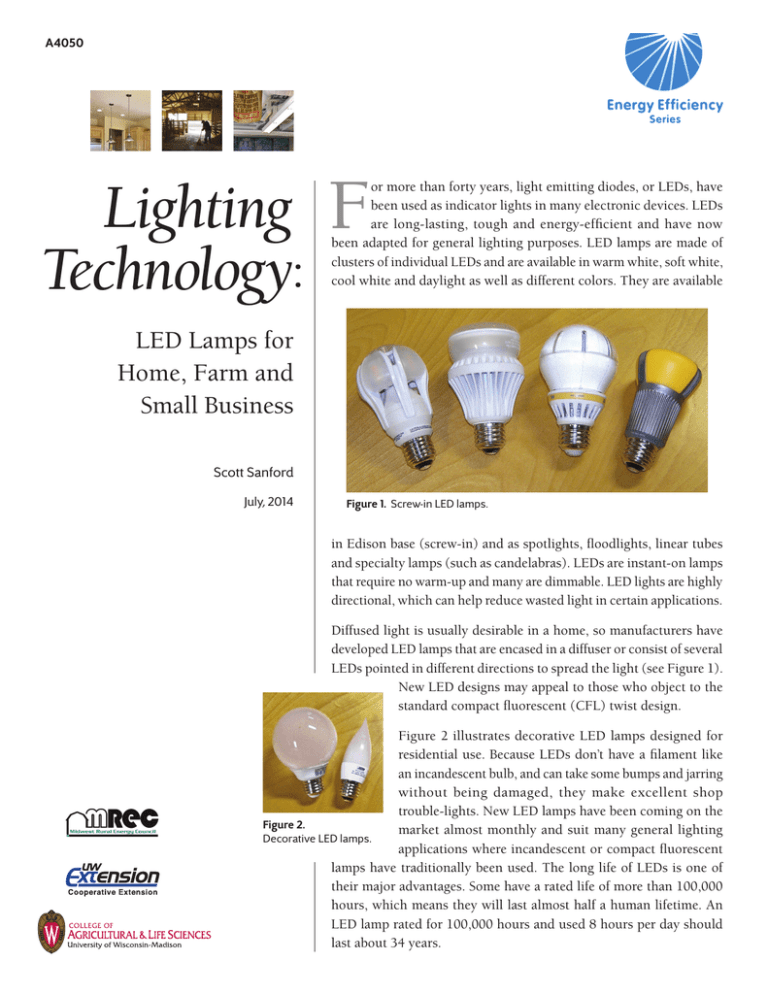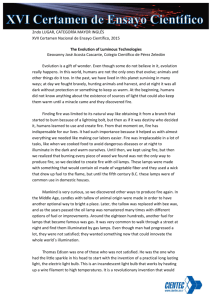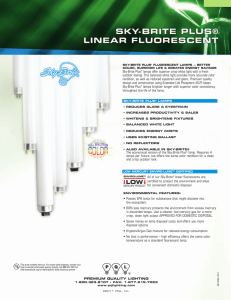
A4050
Lighting F
Technology:
or more than forty years, light emitting diodes, or LEDs, have
been used as indicator lights in many electronic devices. LEDs
are long-lasting, tough and energy-efficient and have now
been adapted for general lighting purposes. LED lamps are made of
clusters of individual LEDs and are available in warm white, soft white,
cool white and daylight as well as different colors. They are available
LED Lamps for
Home, Farm and
Small Business
Scott Sanford
July, 2014
Figure 1. Screw-in LED lamps.
in Edison base (screw-in) and as spotlights, floodlights, linear tubes
and specialty lamps (such as candelabras). LEDs are instant-on lamps
that require no warm-up and many are dimmable. LED lights are highly
directional, which can help reduce wasted light in certain applications.
Diffused light is usually desirable in a home, so manufacturers have
developed LED lamps that are encased in a diffuser or consist of several
LEDs pointed in different directions to spread the light (see Figure 1).
New LED designs may appeal to those who object to the
standard compact fluorescent (CFL) twist design.
Figure 2 illustrates decorative LED lamps designed for
residential use. Because LEDs don’t have a filament like
an incandescent bulb, and can take some bumps and jarring
without being damaged, they make excellent shop
trouble-lights. New LED lamps have been coming on the
Figure 2.
market almost monthly and suit many general lighting
Decorative LED lamps.
applications where incandescent or compact fluorescent
lamps have traditionally been used. The long life of LEDs is one of
their major advantages. Some have a rated life of more than 100,000
hours, which means they will last almost half a human lifetime. An
LED lamp rated for 100,000 hours and used 8 hours per day should
last about 34 years.
Energy Efficiency Series
Figure 3.
LED jelly jar with
heat-dissipating
design.
“The light output
of fluorescent
lamps can
decrease 50% or
more in cold
weather.”
LED lamps are cold-loving and increase their light output by 20% as
the temperature drops from 75°F to -20°F. This makes them an excellent
choice for use in free-stall barns, cold storage facilities or refrigerated
display cases. By contrast, the light output of fluorescent lamps can
decrease 50% or more in cold weather. LEDs are sensitive to heat, but
that is rarely a problem in the upper Midwest where ambient air
temperatures are moderate. LED lamps and fixtures are designed with
heat sinks and sometimes with forced-air convection to aid in keeping
them cool. They are not ideal for use in jelly jar enclosures or other
sealed fixtures unless they are specifically designed to dissipate heat,
like the one shown in Figure 3.
Many companies make LED tube lamps
(Figure 4) to replace T8 linear fluorescent
lamps. If you have a 4-foot T12 or T8 fixture
that is in good condition and that has the
correct type of housing for the application, it
can be converted to accommodate an LED tube
Figure 4. LED tube lamp.
lamp and its driver after the fluorescent lamp
and ballast have been removed. The fixture will need to be rewired
and may require a driver be mounted in the fixture housing
if the manufacturer has not incorporated the LED driver in
the tube. (The National Electrical Code requires fixtures in
animal housing or other damp environments to be rated
water-resistant and to have a cover with a gasket.) High bay
LED fixtures (Figure 5) are available to replace mercury
vapor or metal halide high bay fixtures.
Figure 5.
Table 1. Energy use (watts) and
light output (lumens) of various
general-purpose lamps.
Watts versus lumens
LED high bay lamp.
We are accustomed to judging a lamp’s brightness by the number of
watts it uses, but the watt is actually a
Compact
measure of energy use, not brightness. The
Incandescent
Halogen
LED
Lumens
Fluorescent
lumen is the unit of measure that indicates
465-600
40
28
9
8
a lamp’s light output. For instance, a typical
750-940
60
43
13
10-12
60-watt incandescent bulb emits about
1050-1170
75
53
18
14-17
850 lumens of light, yet an 11-watt LED
1490-1675
100
72
23
22
lamp emits about that same number of
(not available)
2680-2800
150
42
26
lumens. Table 1 lists the lamp wattage and
typical light output of dif­ferent types of
Cover images: home lighting, David Springer; farm building,
lamps. LEDs use 76% to 83% less energy than halogen or incandescent
UW–Madison CALS; small business lighting, Greensburg Greentown.
Four LED lamps and two decorative lamps, Scott Sanford.
bulbs and 15% to 20% less than compact fluorescent lamps.
Above images: Jelly jar, Scott Sanford; LED tube lamp, J 'n J Sales, LLC;
LED high bay lamp, J & D Manufacturing
2 Lighting Technology: LED Lamps for Home, Farm and Small Business
Energy Efficiency Series
Don’t get sticker shock!
LED lamps cost more than other types but when their low energy costs
and low replacement costs (due to their long life) are taken into
account, they are economical. The best way to illustrate this is with
examples.
TIE-STALL DAIRY BARN EXAMPLE
A
Table 2. Lamp specifications.
Lamp Type
Power use
in watts
Incandescent
100
Halogen
72
CFL
26
LED screw-in
22
4-ft T8 fluorescent
68
4-ft LED tube
46
Barn image: USDA Dairy Forage Research Center;
dairyman wants to upgrade his dairy barn’s lighting because the
100-watt incandescent bulbs he’s been using are no longer available
(due to the nationwide phase-out of general-purpose incandescent
bulbs). The 200-foot by 34-foot tie-stall barn currently has three
rows of 100-watt incandescent bulbs spaced every 10 feet for a total
of 60 fixtures. The lights are used an average of 8 hours per day and
the electricity cost is $0.12 per kWh. The lamp replacement options
include halogen (a more efficient type of incandescent bulb), CFL,
screw-in LED lamps, 4-foot T8 fluorescent tube fixtures and 4-foot
LED tube fixtures.
The objective is to
Light output
Lumens/
Lamp or bulb
Cost per
in lumens
watts
life in hours
lamp or bulb
supply as much light
$1.20
1,530
15
750
as the incandescent
$1.75
1,490
21
1,000
lamps provided, or
$6.50
1,550
60
8,000
more. Table 2 shows
$55
the energy use, light
1,700
81
25,000
output, lamp life and
$3.50
5,600
81
20,000
per-lamp cost of each
$70
4,600
100
100,000
option.
The current incan­descent bulbs supply approximately 92,000 lumens
of light (60 bulbs). Halogen, CFL and LED screw-in bulbs would
replace incandescent bulbs on a one-to-one basis, supplying
approximately the same amount of light, and would not require new
fixtures or rewiring. T8 fluorescent and LED tube lamps produce more
light per lamp/fixture than incandescent, halogen or CFL lamps, so
fewer would be needed to provide the same amount of light. Producing
the same amount of light would require seventeen T8 fixtures or twenty
LED tube fixtures, but to make an even number for spacing on three
rows we increase the fixture numbers to eighteen or twenty-one,
respectively. An installation cost of $100 per fixture is assumed for T8
or LED tube fixtures, along with a cost of $100 for a 4-foot wet-location
Lighting Technology: LED Lamps for Home, Farm and Small Business 3
Energy Efficiency Series
Table 3. Tie-stall barn example
lighting options and savings
compared to incandescent option.
Lamp Type
Electricity
cost ($/yr)
Incandescent
$2,102
Halogen
$1,514
CFL1
$547
LED screw-in
$463
4-ft T8 fluorescent2
$429
4-ft LED tube3
$338
1) Life expectancy lowered to 4,000 hours
based on experience in damp environments.
2) 18 fixtures.
3) 21 fixtures.
4) Does not include labor cost for lamp
replacement but includes fixture cost for
4-foot T8 and LED fixtures.
T8 fixture, or a cost of $190 for a 4-foot LED tube fixture (including
lamp and driver). Both the fixture and installation costs are amortized
over 10 years. Costs of electricity, lamp replacement (without labor)
and installation (for the T8 and LED tube fixtures) are included.
This analysis
(summarized in
Annualized lamp
Annual cost
Savings
$ per
replacement cost
($/yr)
($/yr)
100
lumens
table 3) shows that
(4/yr)
the incandescent
$280
$2,382
$2.60
–
and halogen lamps
$307
$1,821
$561
$2.04
have the highest
$285
$831
$1,551
$0.89
annual cost, with
$385
$848
$1,534
$0.79
energy accounting
$378
$807
$1,575
$0.82
for about 85% of
$315
$653
$1,729
$0.68
that cost. This
annual cost is more
than twice that of any of the other options. The 4-foot LED tube fixtures
have the lowest annual cost, 76% less than the incan­descent bulbs.
The CFL, LED screw-in and T8 fluorescent options are all a close
second to the LED tube lamp. In the future, LED options should
offer even further advantages since the cost of LED lamps is
declining as manufacturing volume increases and new products enter
the market.
4
YARD LIGHT REPLACEMENT EXAMPLE
T
he typical yard light is a 175-watt mercury vapor (MV) fixture.
These fixtures are no longer being made and replacement ballasts
have been discontinued. Possible replacements are high-pressure sodium
(HPS) lamps or LED lamps. To match the lumen output of the original
mercury vapor lamp, a 100-watt HPS or 80-watt LED lamp will be needed.
Total power consumption (energy use of both lamp and ballast) of the
mercury vapor lamp is 213 watts and of the HPS lamp is 130 watts.
In comparing the options we will assume that the lamps will be used
an average of 12 hours per day for 365 days per year and that the cost
of electricity is $0.12 per kWh. The cost of one replacement lamp for
the MV and HPS options is included so that those options match the
50,000-hour lamp life of the LED option. The fixture cost is included
for the HPS and LED lamps, annualized over 10 years at a discount
rate of 7% annually.
Yard light image: Scott Sanford
4 Lighting Technology: LED Lamps for Home, Farm and Small Business
Energy Efficiency Series
Table 4. Yard lamp comparison.
Lamp Type
Watts
Fixture $
Lamp Cost**
Energy $*
Total Cost*
Mercury vapor
213
discontinued
$20
$112
$132
High-pressure sodium
130
$110
$32
$68
$100
LED
80
$490
$52
$42
$94
* Annualized costs.
** Includes lamp replacement and fixture cost.
Based on these assumptions, the LED lamps would reduce ownership
costs by 28% compared to the MV lamp and by 5% compared to the
HPS. (Labor costs to change lamps and lamp disposal costs for spent
lamps for the HPS and MV lamps were not included.)
FREE-STALL BARN LIGHTING EXAMPLE
M
etal halide lamps and T5 or T8 fluorescent lamps have typically
been used for free-stall lighting. LED lamps have advantages over
both these types of lamps. LED light output doesn’t decrease in cold
weather and lamp life is two to four times longer.
Table 5. Free-stall general purpose lamp comparison.
Lamp Type
Watts
Fixture $
Lamp/Fixture
Cost*
Energy $*
Total Cost*
Pulse-start metal halide (PSMH) (250-w)
294
$325
$60
$154
$215
T5 – 4-lamp 54HO
245
$340
$50
$129
$179
LED
160
$740
$79
$84
$163
* Annualized costs.
Let’s compare costs of a 250-watt pulse-start metal halide (PSMH)
lamp, a T5 4-lamp low bay fixture using T54HO lamps, and an LED
lamp in a low bay fixture. All these fixtures emit approximately the
same amount of light. The fixture costs are amortized over 10 years
at 7% interest. The re-lamping costs for the PSMH and T5 have been
annualized and include $70 for lift rental and labor. The lamp life of
the PSMH is assumed to be 24,000 hours, the T5 lamp life to be 30,000
hours, and 50,000 hours for the LED.
To equal the life of the LED lamp, the PSMH and T5 lamps will need
to be changed once. For this analysis, it is assumed that the LED
fixture will be replaced at the end of its life, approximately 12 years.
This may seem short but there will likely be more efficient LED lamps
by then so replacing the fixture might be economical. Installation costs
Barn image: UW–Madison CALS
Lighting Technology: LED Lamps for Home, Farm and Small Business 5
Energy Efficiency Series
(hanging and wiring) are expected to be the same for all fixtures so
are excluded from the analysis. The lights are operated for 12 hours
per day, 365 days per year at an electricity cost of $0.12 per kWh.
The analysis reveals, see Table 5, that the LED lamp will reduce lighting
costs by 24% compared to the PSMH lamp and by 9% compared to
the T5 lamp.
Disposal and recycling
“LED lamps can
be disposed as
normal trash,
but should be
recycled to
recover the
aluminum.”
LED lamps do not contain mercury but do contain
aluminum, copper and some toxic materials,
including lead, nickel and arsenic. They are very
rugged and unless smashed with a hammer will
not release toxins. They are considered nontoxic
and can be disposed as normal trash but contain an
aluminum heat sink to aid in keeping the diodes
below their critical temperature and should be
recycled to recover the aluminum.
New lamps can be purchased at building supply
outlets, hardware stores or electrical distributors. They may qualify
for energy efficiency incentives, check with your electric utility company
or state energy office.
Measuring light output
Different lamp types produce different wavelengths (colors) of light.
A lumen of light is a weighted average of different wavelengths based
on the color sensitivity of the human eye, which is most sensitive to
green and least sensitive to red and blue. White light is a mix of all
colors but some types of lamps produce more of some wavelengths
than others, even though the perceived color is white.
The typical light meter is optimized for incandescent bulbs, which
emit a wide range of wavelengths. LEDs typically emit one wavelength.
LEDs that emit true white-light are not available. To produce white
light an LED makes use of a blue-emitting diode covered with a
converter material that emits yellow light when stimulated by blue
light. The mixture of blue and yellow is perceived by the human eye
as white. Due to the difference in wavelengths produced by incandescent
and LED lamps, a standard light meter will register lower lumen or
Screw-in LED lamp, Dennis Schroeder, NREL
6 Lighting Technology: LED Lamps for Home, Farm and Small Business
Energy Efficiency Series
foot-candle levels of light from an LED than from an incandescent
lamp emitting the same amount of perceived light. A light meter
designed for LEDs is necessary to get an accurate measurement of their
output.
The output of a lamp or bulb does not necessarily indicate the amount
of useable light from a fixture. Some light is wasted or absorbed by
the light fixture. LED lamp output is typically directional so less
light is wasted and more of the total light output reaches the intended
target area.
LED lamps emit light with a high color-rendering index (CRI). The
CRI is a measure of the perceived color of an object when lit by a
particular lamp compared to the same object’s perceived color when
it is lit by sunlight. Sunlight is indexed at a CRI of 100 and LED lamps
are often rated at a CRI of greater than 90.
“A light meter
designed for LEDs
is necessary to
get an accurate
measurement of
their output.”
When replacing a lamp with low CRI qualities (such as a mercury
vapor lamp) with an LED, the total lumen output from the LED lamp
can usually be lower than the original lamp yet produce the same
amount of perceived light.
Lighting Technology: LED Lamps for Home, Farm and Small Business 7
Lighting Technology: LED Lamps for
Home, Farm and Small Business
Reference to brand names and use of product photos are not an endorsement of any
product, nor is omission of any product a condemnation.
References
Evaluating Light Output – Using Delivered Light to Specify and Compare LED Lighting Fixtures,
Philips Color Kinetics, Burlington, MA, 2010.
Lighting Calculations in the LED Era, J.R. Benya, Cree, Inc., 2011.
The mission of the MREC is to initiate, develop, support, and coordinate education, research, and communication programs on significant
and emerging rural energy issues for the consumer, energy suppliers, and allied industries through cooperative efforts of council members.
www.mrec.org
Author:
Scott Sanford, Rural Energy Program, University of Wisconsin–Madison
Copyright © 2014 by the Board of Regents of the University of Wisconsin System doing business as the division of
Cooperative Extension of the University of Wisconsin-Extension. All rights reserved. Send copyright inquiries to:
Cooperative Extension Publishing, 432 N. Lake St., Rm. 227, Madison, WI 53706, pubs@uwex.edu.
Cooperative Extension publications are subject to peer review.
This publication is available from your county UW-Extension office (www.uwex.edu/ces/cty) and from Cooperative Extension Publishing
(to order, call toll-free: 1-877-947-7827 [WIS-PUBS] or visit this website: learningstore.uwex.edu).
University of Wisconsin-Extension, Cooperative Extension, in cooperation with the U.S. Department of Agriculture and Wisconsin counties, publishes this information to further
the purpose of the May 8 and June 30, 1914, Acts of Congress. An EEO/AA employer, the University of Wisconsin-Extension, Cooperative Extension provides equal opportunities
in employment and programming, including Title IX and ADA requirements. If you need this information in an alternative format, contact Equal Opportunity and Diversity Programs,
University of Wisconsin-Extension, 432 N. Lake St., Rm. 501, Madison, WI 53706, diversity@uwex.edu, phone: (608) 262-0277, fax: (608) 262-8404, TTY: 711 Wisconsin Relay.
UWEX Publication
A4050 I-07-2014
Graphic design by Jeffrey J. Strobel
UW–Extension Environmental Resources Center
Printed on
Recycled Paper
ERC Publication GWQ 067



